Sold - Recent acquisitions - Lehrsammlung - Photo gallery
Image database with photographs of ancient art and antiquities
Our image database provides photographs of ancient art and antiquities for press releases as well as for private use. All artefacts sold in our gallery are documented through professional photographs. The resulting image library contains numerous ancient Egyptian, Greek and Roman antiquities as well as ancient coins. The time span from Stone Age, over Bronze Age and Classical Antiquity until Late Antiquity is covered.The photo gallery aims at providing a vast visual archive equipped with filters and search tools. You are most welcome to search the constantly growing number of artefacts in the image library. We are also happy to authorize hyperlinks from your webpage / forum to the objects depicted in our gallery. For this purpose, please send us a short notification prior to placing a hyperlink. For almost every object high definition photographs are available and can be provided e.g. to document your collection or for scientific papers or popular science articles. If you are interested in using pictures for publications, print media or other purposes, please contact us and we will be happy to assist you.
-
 Roman headstud brooch
Roman headstud broochInteresting fibula with a covered hinge mechanism and enamel decoration on the bow. From the 2nd century Roman Britain. Published in two stardard works on ancient brooches by Richard Hattatt.
Price: on request Roman knee brooch from Britannia
Roman knee brooch from BritanniaWell preserved example of this important fibula type that was introduced to Britain by Roman troop movements from the Rhineland. This specimen was already produced locally in Britannia province. It was published in two books on ancient fibulae.
Price: on request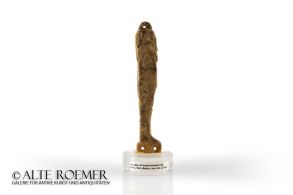 Appliqué of the Horus Son Imsety
Appliqué of the Horus Son ImsetyRare variety with wooden core and gilded linen. Protective god responsible for the liver of a deceased. From the family of Lawrence of Arabia.
Price: on request Egyptian bronze figurine of Horus the Child
Egyptian bronze figurine of Horus the ChildAmulet of a standing child god with crown, sun disc and horns.
Price: on request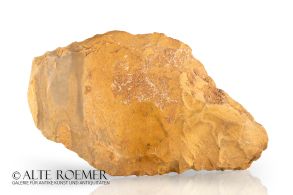 Paleolithic hand axe
Paleolithic hand axePrehistoric stone tool. It was the universal tool of the older Stone age and could be used as a borer or a cutter. From a Swiss museum collection. Found in Morocco, North Africa.
Price: on request Huge Paleolithic hand axe
Huge Paleolithic hand axePrehistoric stone tool. It was the universal tool of the older Stone age and could be used as a borer or a cutter. From a Swiss museum collection. Found in Morocco, North Africa.
Price: on request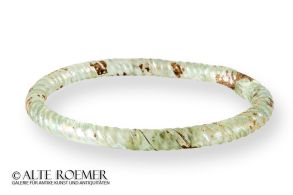 Roman glass bracelet with spiral decoration
Roman glass bracelet with spiral decorationThe 4th century bangle is decorated with spiraling grooves on the outside. Made in the Eastern Mediterranean.
Price: on request Roman glass bracelet with spiral decoration
Roman glass bracelet with spiral decorationThe 4th century bangle is decorated with spiraling grooves on the outside. Made in the Eastern Mediterranean.
Price: on request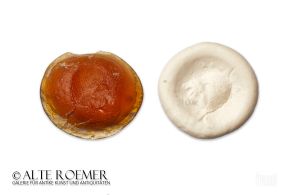 Roman glass paste
Roman glass pasteRing stone made of beautiful orange glass. From the Professor Brosch collection of ancient gems.
Price: on request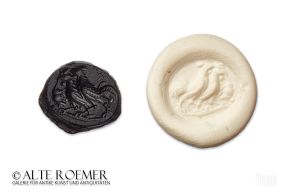 Roman intaglio with cocks
Roman intaglio with cocksThe quality work shows two standing cocks on a base line. Fantastic and crisp illustration.
Price: on request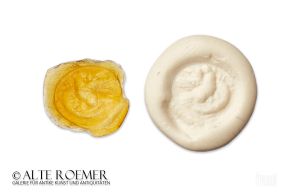 Roman intaglio with eagle
Roman intaglio with eagleThe ancient work shows an eagle in a dynamic movement spreading his wings. Beautiful orange glass paste.
Price: on request Etruscan scarab with Prometheus
Etruscan scarab with PrometheusThe highest quality work of miniature art shows how Prometheus has just formed the first human from clay. A showpiece of late Etruscan glyptics made of beautiful carnelian.
Price: on request Etruscan scarab with horses
Etruscan scarab with horsesGem stone and seal made of beautiful carnelian. It shows two horses in a frontal view in a highly stylized manner. From the famous Giorgio Sangiorgi collection.
Price: on request Glass bottle with nub decoration
Glass bottle with nub decorationThe pear-shaped glass comes from the late Roman or early Byzantine period. Presumably from the Eastern Roman province of Palaestina.
Price: on request Late Roman glass flask
Late Roman glass flaskFlat bottle with double handle from the Eastern Mediterranean. Made between the 3rd and 6th century.
Price: on request Egyptian amulet of Bes
Egyptian amulet of BesProtective amulet of the dwarf god Bes made of turquoise faience. Great specimen from Ptolemaic or Roman Egypt.
Price: on request Appliqué of the Horus Son Imsety from Faiyum
Appliqué of the Horus Son Imsety from FaiyumMade of nice turquoise faience. Protective god responsible for the liver of a deceased. From the family of Lawrence of Arabia.
Price: on request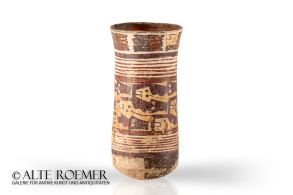 Beaker of the Nazca culture
Beaker of the Nazca cultureTall and slender vessel from the pre-Columbian Nazca culture. The polychrome painting shows abstract patterns, as well as abstracted animals and faces.
Price: on request Beaker of the Nazca culture
Beaker of the Nazca cultureElegant vessel of the pre-Columbian Nazca culture. The polychrome painting is of high artistic quality and shows a mask.
Price: on request Richly painted pottery in the Nazca style
Richly painted pottery in the Nazca styleA magnificent modern product imitating the style of the pre-Columbian Nazca culture. It depicts a deity, a hybrid creature of mythical beast and human.
Price: on request Bowl of the Nazca culture
Bowl of the Nazca cultureWith polychrome abstract depiction of people and masks, possibly a deity. Wonderful vessel from the Nazca Golden Age.
Price: on request Bowl of the Nazca culture
Bowl of the Nazca cultureWith polychrome abstract depiction of people and masks, possibly a deity. Nice vessel from the Nazca Golden Age.
Price: on request Roman intaglio with griffin
Roman intaglio with griffinThe ancient work shows a griffin composed of horse and eagle. The mighty wings are raised above the back, the forepart and paws are erect.
Price: on request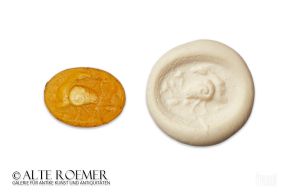 Roman intaglio with gryllos
Roman intaglio with gryllosThe hybrid creature was extremely popular during the Roman Empire. It was believed to convey magical powers.
Price: on request Roman intaglio with eagle
Roman intaglio with eagleThe ancient work shows an eagle in a dynamic movement spreading his wings. Beautiful orange glass paste.
Price: on request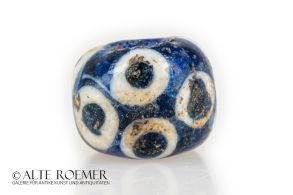 Phoenician eye bead
Phoenician eye beadPolychrome glass bead with stylized elements of a face as protection against the evil eye. Produced in Carthage or the Phoenician homeland, 4th to 3rd century BC.
Price: on request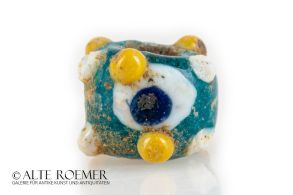 Phoenician eye bead
Phoenician eye beadPolychrome glass bead with stylized elements of a face as protection against the evil eye. Produced in Carthage or the Phoenician homeland, 4th to 3rd century BC.
Price: on request Phoenician eye bead
Phoenician eye beadPolychrome glass bead with stylized elements of a face as protection against the evil eye. Produced in Carthage or the Phoenician homeland, 4th to 3rd century BC.
Price: on request Egyptian ushabti
Egyptian ushabtiWell-preserved funerary statuette made of mint green faience. From the Late Period of Ancient Egypt.
Price: on request Egyptian amulet of Bes
Egyptian amulet of BesProtective amulet of the dwarf god Bes made of turquoise faience. Great specimen from Ptolemaic or Roman Egypt.
Price: on request Marc Antony legionary Denarius from Wishanger hoard
Marc Antony legionary Denarius from Wishanger hoardFound 2021 in East Hampshire, UK. The hoard is a very impressive proof of the fact that coins were in circulation for up to several centuries in the Roman era.
Price: on request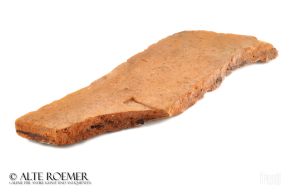 Large Roman legionary tile from the Rhineland
Large Roman legionary tile from the RhinelandFound 1966 till 1981 near the Roman city of Novaesium, today's Neuss in Germany. Novaesium was an early Roman foundation and with this is one of the oldest cities in Germany.
Price: on request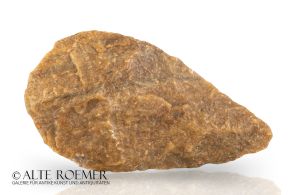 Large Paleolithic hand axe
Large Paleolithic hand axePrehistoric stone tool. It was the universal tool of the older Stone age and could be used as a borer or a cutter. From a Swiss museum collection. Found in Erg Mehedjibat, Algeria, North Africa.
Price: on request Paleolithic hand axe
Paleolithic hand axePrehistoric stone tool. It was the universal tool of the older Stone age and could be used as a borer or a cutter. From a Swiss museum collection. Found in Erg Mehedjibat, Algeria, North Africa.
Price: on request Neolithic axe head with through hole
Neolithic axe head with through holeFinely crafted tool from the New Stone Age of Europe. Made from greenish grey rock. With a through hole at the neck as a remarkable feature.
Price: on request Bronze Age bracelet with incised decoration
Bronze Age bracelet with incised decorationThe jewellery was made in Europe during the 2nd millennium BC. Nice, dark patina.
Price: on request

